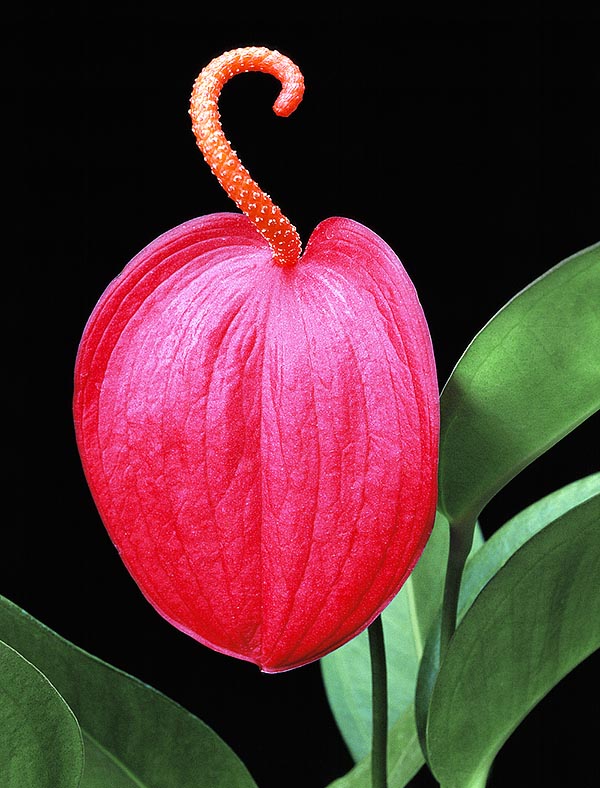Family : Araceae

Text © Pietro Puccio

English translation by Mario Beltramini

Native to Costa Rica, the Anthurium scherzerianum is one of the most known indoor plants due to the flaming and lasting inflorescence spathe. The fruits are orange red berries © Giuseppe Mazza
The name of the genus is the combination of the Greek wordings “anthos” = flower and “oura” = tail, with reference to the spadix of the inflorescence; the name of the species is honoured to the discoverer and collector, the Austrian naturalist Karl Ritter von Scherzer (1821-1903).
Common names: “anturio” (Italian); “flamingo flower”, “devils tongue”, “pigtail anthurium”, “tail flower”, “tailflower” (English); “anthure”, “flamant rose”, “langue de feu”, “petit anthurium” (French); “anturio-rabinho-de-porco”, “flor-de-flamingo”, “rabinho-de-porco” (Portuguese); “anturio”, “flor del flamenco”, “lengua de Diablo” (Spanish); “Anthurie”, “Flamingoblume”, “Kleine Flamingoblume”, “Scherzers Anthurium” (German).
Perennial, rhizomatous herbaceous, epiphyte, with very short stems, it has linear to lance-shaped leaves, long from 5 to 30 cm and broad from 3 to 7 cm, with a sharp apex, of a semiglossy dark green colour on the upper page, dull on the inferior one, on petioles long up to 30 cm.
The long-lasting (6-8 weeks) inflorescences are axillary, erect, on a peduncle long from 15 to 50 cm and formed by a showy spathe, ovate, long from 4 to 12 cm and broad from 3 to 6 cm, of a bright orange red colour, and a spadix long up to about 8 cm, usually curved, of an orange yellow to red colour, on which are wound in a spiral several tens of small hermaphrodite protogeneous flowers, (the stigma, the female part, is receptive before the ripening of the seed, thus preventing the self-fertilization).
The fruits are bright orange red berries. It reproduces by seed, by division or apical cutting provided with provisional roots; industrially, by micro-propagation in vitro.
The plant is cultivable in open spaces in the humid tropical zones in the shade, on draining organic substrata, elsewhere, is to be cultivated in pot and as such is one of the most appreciated flower plants for indoor decorations.
When in a flat, it is to be placed in a very luminous position, but far away from the direct sun, the substratum must be organic and very porous, with a good water retention and in the mean water well drained and ventilated in order to avoid root rottenness.
The temperature is to be kept over the 15-16 °C, better around the 20-22 °C, without sudden variations; even if being less demanding about local humidity, if compared to other species of Anthurium, we have to avoid too dry rooms, as it is a plant which, however, in the wild lives in areas with a great atmospheric humidity.
During the vegetative period, watering are to be regular and the substratum is to be constantly kept humid, but without stagnations, during the winter watering are to be slowed down, especially if the temperatures are close to the lowest limit, but without leaving the substratum to dry up completely.
All the parts of the plant contain calcium oxalate, therefore it is wise to put in practice at least some precautions when handling the plant in order to avoid possible skin problems and also to avoid that domestic animals chew and swallow any part of same.
Synonyms: Anthurium scherzerianum var. williamsii (Engl.) Engl. (1879); Anthurium williamsii Engl. (1879).
